Usually I write in Finnish, but since all the content is in English, I find it easier to make notes on the fly with the same language. Hence English.
This post is about the biggest business event in Finland – Nordic Business Forum. It gathers over 7500 business people for two days in Helsinki and boasts with a world class line up of keynote speakers. I have joined the event several times and every time I try to learn something new.
But learning is not enough. I think that attending this kind of an event should also lead to new ways to do business. If you want to do that, you need to take your learnings into action and change the way you act. This is why I have tried, in addition to making notes of each keynote, write few thoughts of how I’m going to change my behavior or the way I do things.
Post is published as I made the notes during the event. So I hope you bare with my spelling or grammar mistakes…
Start of the Day #1
Pep Rosenfeld, Moderator
Lively guy. GDPR and Trump jokes were good. But why a GDPR joke? Well, he got the audience warmed up for the first speaker and was not talking too much about himself. After all, event is never about the moderator, right?
Aswath Damodaran – Laws of Valuation: Revealing the Myths and Misconceptions (STRATEGY)
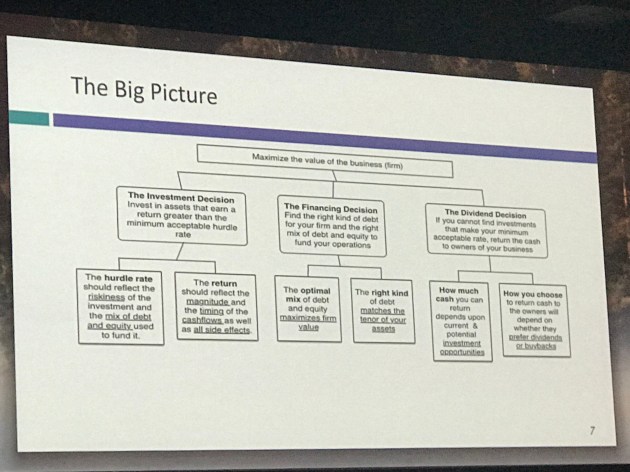
”Old young companies” like Tesla and Uber are like teenagers. They behave sometimes really stupidly. They don’t think about the consequences.
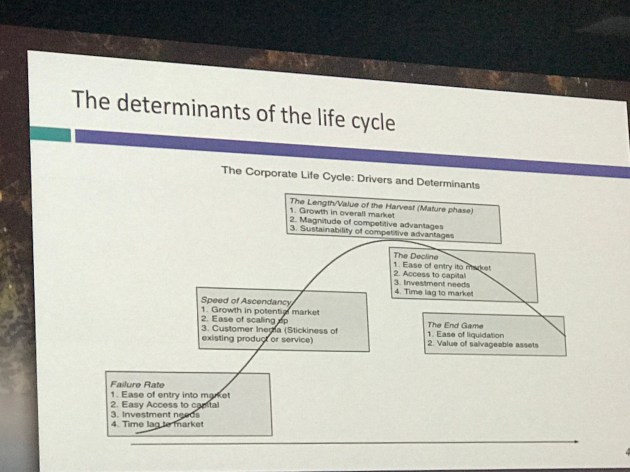
Tech companies don’t have long mature period, because disruptions are always around the corner. This happened to Yahoo, Nokia, BlackBerry.

Corporate finance across the life cycle
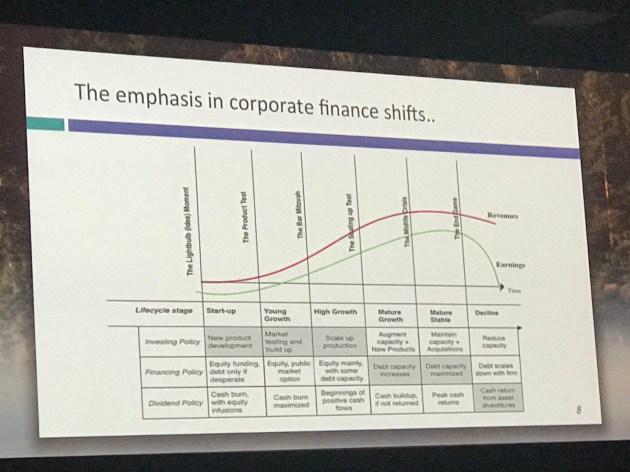
- Find the mix of debt and equity!
- Mix of these decisions changes between the life stages
- You should give dividends only if you don’t find better investment target within your own business.
Companies, act according to your age and stage in the lifecycle!
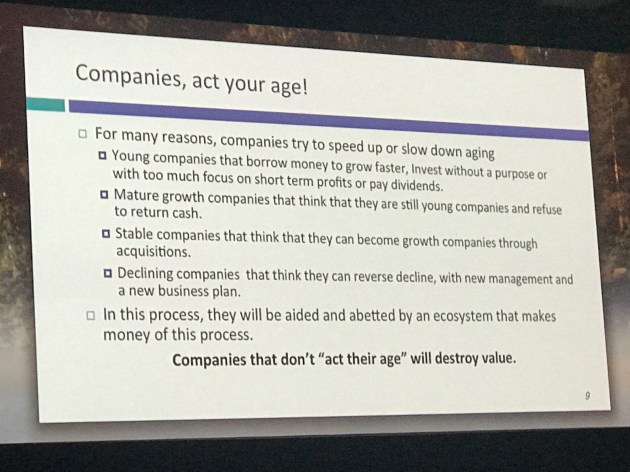
- You should understand your stage and age and use right finance tools accordingly. Cash burn is not a bug, it is a feature. If you are young. (Personal note: it’s funny how companies spending is similar to humans: as a child, you burn money, as a grown up you invest money to growth (your kids etc.) and as a senior citizen you start to pay dividends to yourself (spend the money you have earned during your adulthood…)
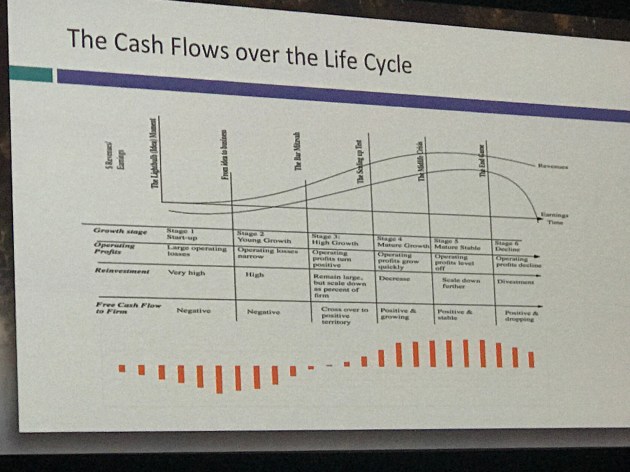
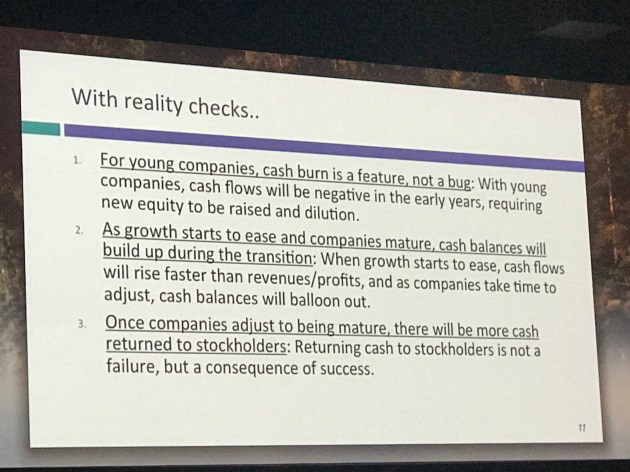
- Start up: don’t borrow money to invest without purpose or to pay dividends
- Mature companies: pay dividends!
- Declining companies: new business plan don’t help..
At some point, when growing older, cash burn have to stop. (It’s actually like that with humans…)
Amazon is a disruption platform with an army, which can go into any business in the world. It will most likely not make money in that business, but all other players will loose a huge amount of money. It’s behaving like a young company with billions of money.
VALUE = STORY + NUMBERS

With young company: it’s only about the story. Better story can take you from 15B€ to 65B€ valuation.
What is the right CEO for:
young company: Steve the Storyteller
Growing company: Bob the builder
Mature company: Don the Defender
Declining company: Larry the Liquidator
This topic was really interesting, but was left with only one minute at the end of the keynote. Loved to hear more!
What to change? Keynote was a good reminder of doing right things at the right phase. I understood that instead of paying dividends in my own company, at this stage, we should seek more rigorously for growth opportunities. We are still in the growth phase.
James Hewitt – The Key to Sustainable High Performance (PEAK PERFORMANCE)
Winner of the speaking contest. Guy with a very strange cyborg hat on his head 🙂 It was used to measure stress and focus. Speaker knows a lot about cycling, which is always a good thing!
Knowledge work is endurance activity. What is the key to sustainable high performance?
We never rest, we rarely focus. We can’t always be ”ON”.
Apply effort in the right time and right place. Effort at the wrong time – and you don’t win! Follow your own rhythm. That brings sustainable performance.
Better result, similar effort:
- Apply at the right time
- Rest and recover
- Find your rhythm
Rhythms in cognitive performance?
- Peak – Valley – Rebound (early birds)
- Rebound – Valley – Peak (Owls)
(Personal note: this topic was discussed few days ago in Helsingin Sanomat https://www.hs.fi/teknologia/art-2000005838301.html for subscribers only)
30% of the work could already be automated, 70% not: Collaboration, Creativity, Complex problem solving.
Humans should not try to work like machines. Optimise, don’t maximize. Are you aware of your rhythms? Do your work accordingly?
Plan: Cognitive gears: Rest, Menial Tasks, Focus. We are stuck with menial tasks, into the middle gear.
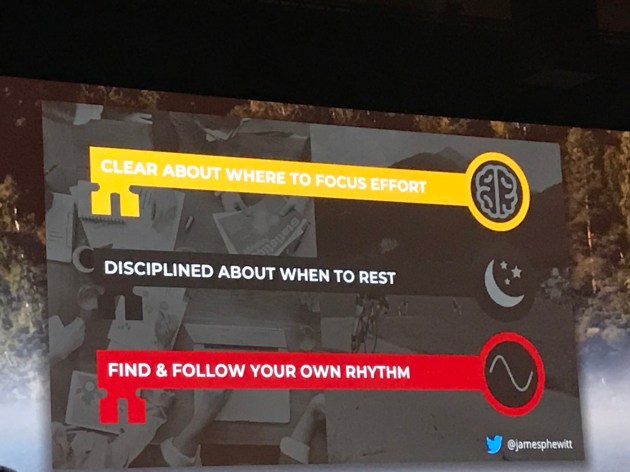
What can we do? Don’t make perfect an enemy of good enough.
Schedule high gear during peak: 25 min on, 5 min off. Sleep 7-9 hours per night. Create boundaries for switching tasks. Starting the day with an email is starting with someone else’s schedule.

Wellbeing is strategic importance.
What to change? James is a great performer and I specially like his background in cycling. It makes everybody so much more professional 🙂
In the future, I try to make all important things in the morning and forget all notifications and menial tasks during those early hours. Then I’ll give myself a permission to sleep, if I’m tired, eat, if I’m hungry and work when I’m in my most productive mood. I try to follow my own personal rhythm more.
Susan Cain – Quiet: How to Harness the Strengths of Introverts to Change How We Work, Lead, and Innovate
Is the ideal leader bold, alpha & gregarious? The ideal thinker?
How do you feal after two hours at a fun party? Does your battery get’s empty or reloaded?
- Introverts and extroverts are wired differently
- Extroverts nervous system reacts less to signals
(Personal note: It’s not a party, if it lasts only two hours, c’mon!! Well, it seams that I’m quite extrovert.)
Extroverts do fine, when the background noise is loud. And introverts vice versa. There is no ”one side fits all” work place.
My note: teams consists of different types of people and usually teams sit together…
60% introverts and 40% extroverts in the audience according to the ”raise your hand” -test.
Successful companies have Yin & Yang -founders: introvert and extrovert. For example the Apple. (Personal note: I think we have pretty much the same thing, although Rami also knows how to party…)
We are naturally so social, that we pick up each other ideas. If you really wan’t to learn, what is truly you, you have to spend time alone. A lot.
3 people usually takes care of 70% of talking in a large meeting. So should we have meetings at all?
- Introverts: speak early! If you wait too long, you drift aside.
- Introverts: don’t curb your enthusiasm! Extroverts, you can curb yours a little.
- Extroverts: engage introverts 1-on-1 and give them advance notice to prep.
Good to great -results:
- All super successful companies were led by a CEO, who were considered with introvert features (modest, soft spoken etc.)
Letter of thanks: leader of Campbell Soup wrote 13 000 thank you letters to outstanding employees!
What to do?
- Enter, Exit and Return to your comfort zone
- Win your fear by exposing yourself to it – but in small steps and portions
- Groom an ”unlikely” leader
- Find role models who are like you
- Know what is in your suitcase – metaphor for knowing what is important for you. Share it with others.
What to change? I’ll speak less in the beginning of the meetings and give more space to introverts and try to engage them more.
END OF SESSION ONE, DAY ONE
Second session was started by a deaf musician. We’ve seen this before in NBF many times: first this person is on a video (this time in Talent America) and the she appears suddenly on stage – live. For me it was a big surprise how well a deaf person can sing. How? Unbelievable.
Gary Hamel – Building an “Evolutionary Advantage” (STRATEGY)
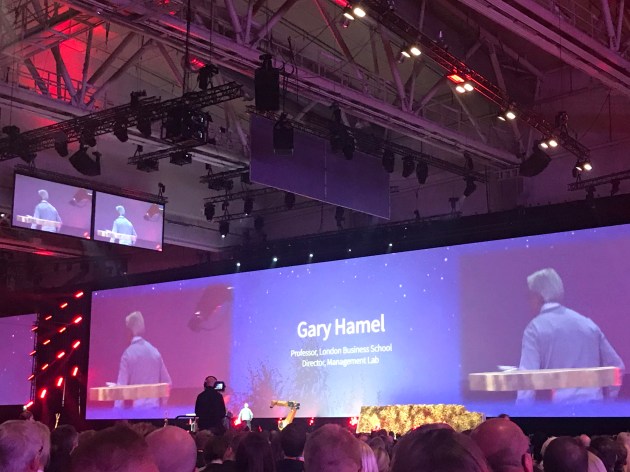
Picture above tells about the scale of the event. Spot Gary on stage (next to the robot)
World, where change has changed!

Knowledge doubles every 18 months, they use even robots in brothels! Are we changing as fast as the world around us. World is more turbulent that we are resilient.
1998: Walmart against Amazon revenue rate 240:1 in 1998. Now Amazon 5 times more expensive. Tesla sold more luxury cars in Europe than Audi, BMW and Mercedes together.

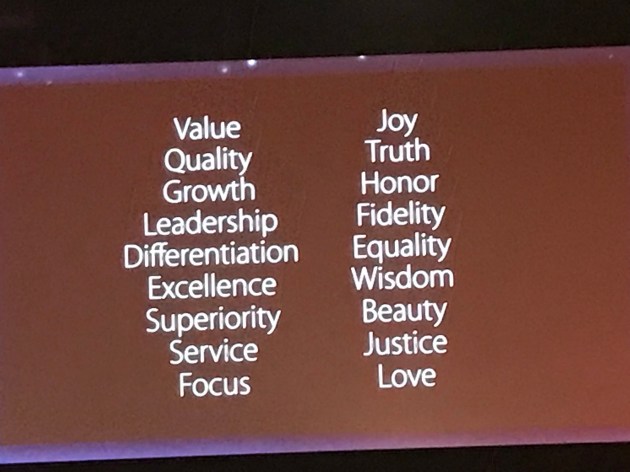

What business we are in?
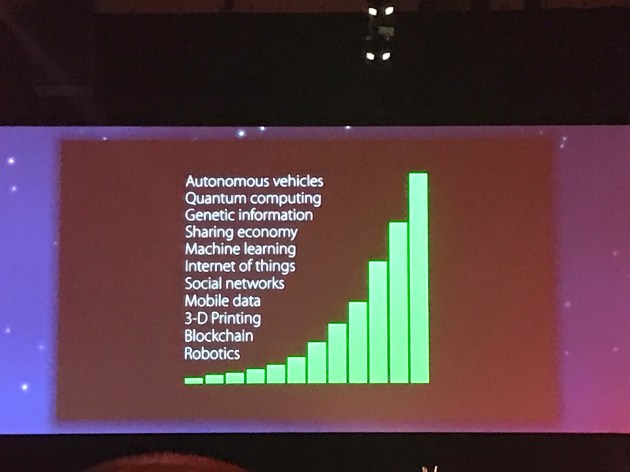
Big companies wan’t to get bigger in order to shape the politics and restrict new commerce. They do rather that than reimagine themselves.
People are not against the change! Our organizations and their structure is against change.
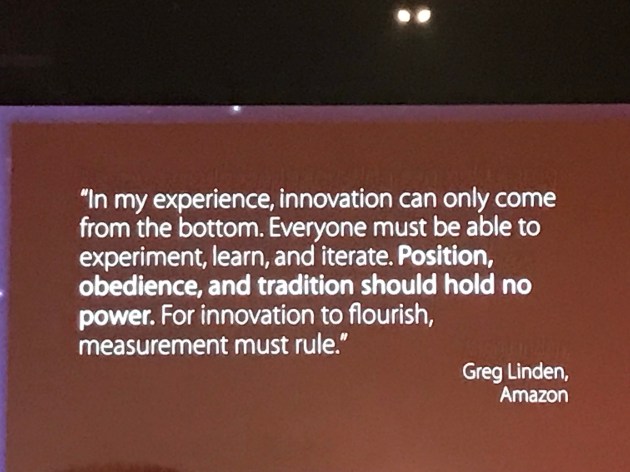
How do you build evolutionary advantage?

- Cognitive. Future is surprisingly indifferent to our preferences. The top leaders usually fail to write off their own intellectual capital. In other words: they wan’t to stick with decisions they made 10 years ago. CEO’s need to be social architects. Be humble. Treat everything as a hypothesis.
- Strategic. Generating new options —> you need to do this constantly. You need to create a lot of options to find the winner. Strategic planning is an oxymoron – there is no such thing. It’s like airplane food. Strategy is creating new options. Options have to come from all level of organization.
- Political. Creating internal markets. It’s about how you allocate money. Internal politics (how do we fund businesses) is very inefficient. It is usually done based on the last years budget. Hence: we get more of the same, rich get richer, share the pain, loyalty is virtue (kill your darlings!), defend what’s yours! In most organizations there is only one buyer for new ideas. Gate keepers! It’s like Silicon Valley would have only one VC-company that would make all the decisions. IBM is trying to change this internally by using IBM ifundIT – an internal tool to get multiple opinions about new ideas.
- Emotional. Finding a bigger dream. In most companies aspirations equals to resources. That ratio should be 10:1. Then you don’t improve, you invent. Apple understands how to touch your heart.”How do we make you feel?” When did your bank ask that from you?
- Ideological. Re-imagining trade-offs. Manage = Control. Without it it’s going to be a chaos. But we’ve gone way to far in this. We have to re-invent control. Peer control is way better than fear. Values are better than rules.
I liked Hamels keynote (the content), but hated his way to yell with a very high note through the presentation.
What to change? I liked the idea that team chooses their colleagues. We do this already. But could team choose their own leaders as well? It’s an idea to explore. As long as I have the majority of shares, I shouldn’t worry about my position as CEO 🙂
Amy Cuddy – Presence: Bringing Your Boldest Self to Your Biggest Challenges
Confidence is a tool. Arrogance is a weapon.
If you are not present, you do not believe in your story. Especially important when selling. Words and body language needs to be in line. Presence liberates other people to be present. It tells that you can trust me.
Instead of concentrating to the outcome, concentrate on the process.
Tiny tweaks —> Big changes
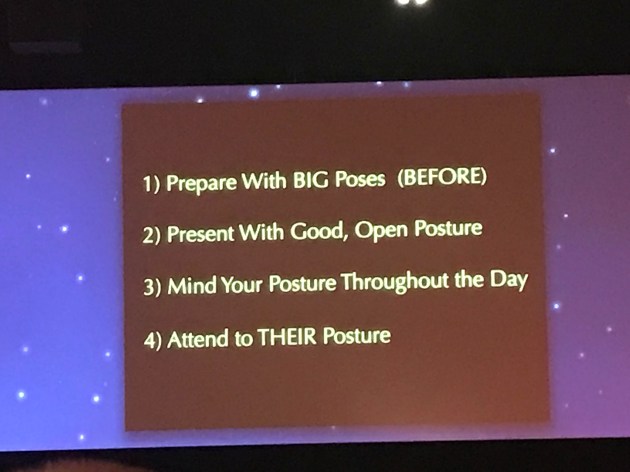
Amy spent like 5 minutes to show different ”winner postures”. I think the audience got the point in two first pictures. Hence, she was in a hurry towards the end.
Keynote was OK and Amy is a good speaker. However, I would rather see this keynote at the ”Retoriikan kesäkoulu” or some other conference for better speaking and becoming a better presenter. And ending the presentation to a kind of a sidetrack, was confusing. I have a daughter and I think that girls (and boys) are important but giving hints of how girls upbringing in a business seminar was rather odd.
What to change? Well… this was maybe the least valuable presentation for me during the day one. I’m going to raise my hands also in the future whenever I win something. That’s for sure…
END OF SESSION TWO, DAY ONE
At this point there were still two keynotes left. But I decided to do what James Hewitt told us to do: go with your own rhythm. My bottom was sore from sitting and I needed to get out. I decided to head to Espoo’s Central Park with my friend Jussi and test his new e-MTB. Have to be honest, two hours in a dark forest with a super cool MTB was the highlight of the day.
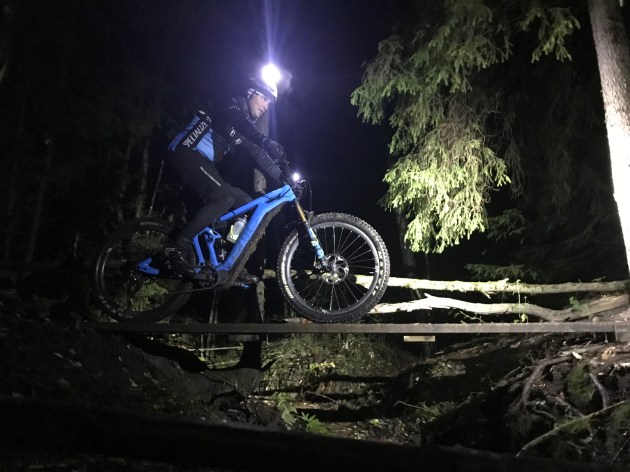
And even better: this kept me out from the city and all the parties in town. I got to sleep better and now I’m ready for day #2 and mr. Obama!
Enjoy your day!
Petri
Paluuviite: SaaStock 2018 – personal notes and take home messages | Perjantaikokin blogi